Unit 5 Into the Unknown Developing ideas 课件(共20张PPT)-2025-2026学年外研版(2019)选择性必修四册
文档属性
| 名称 | Unit 5 Into the Unknown Developing ideas 课件(共20张PPT)-2025-2026学年外研版(2019)选择性必修四册 | 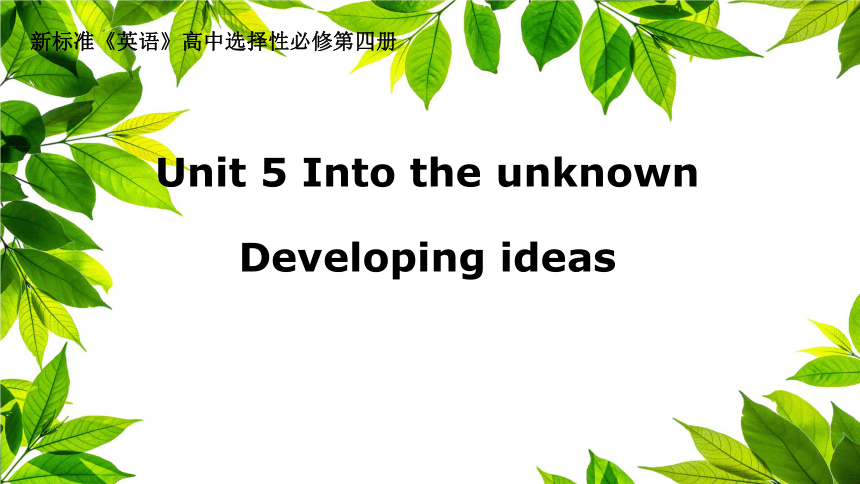 | |
| 格式 | pptx | ||
| 文件大小 | 5.9MB | ||
| 资源类型 | 教案 | ||
| 版本资源 | 外研版(2019) | ||
| 科目 | 英语 | ||
| 更新时间 | 2025-07-18 08:21:55 | ||
图片预览

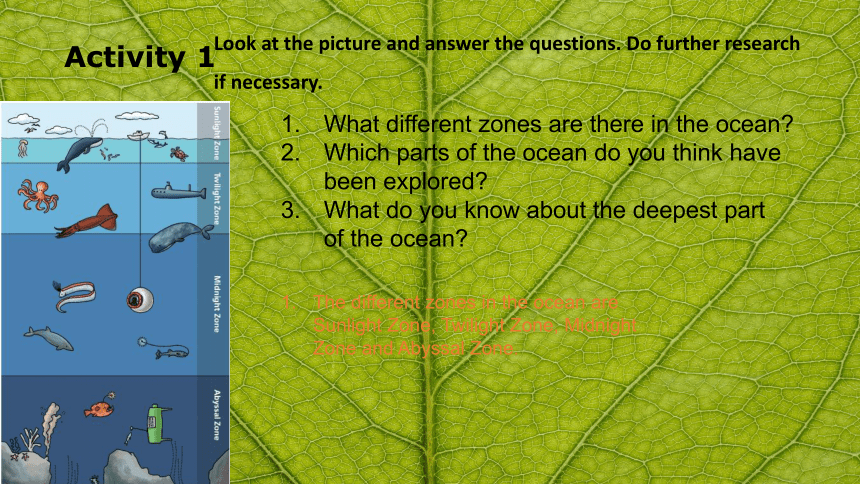
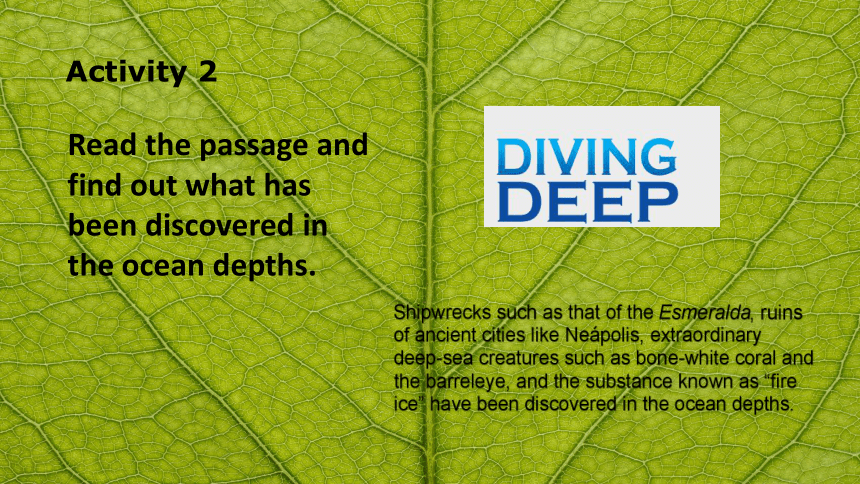
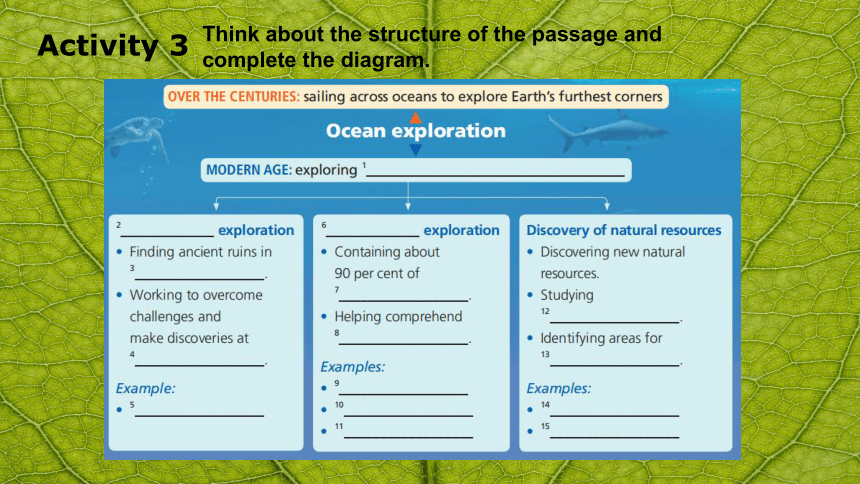
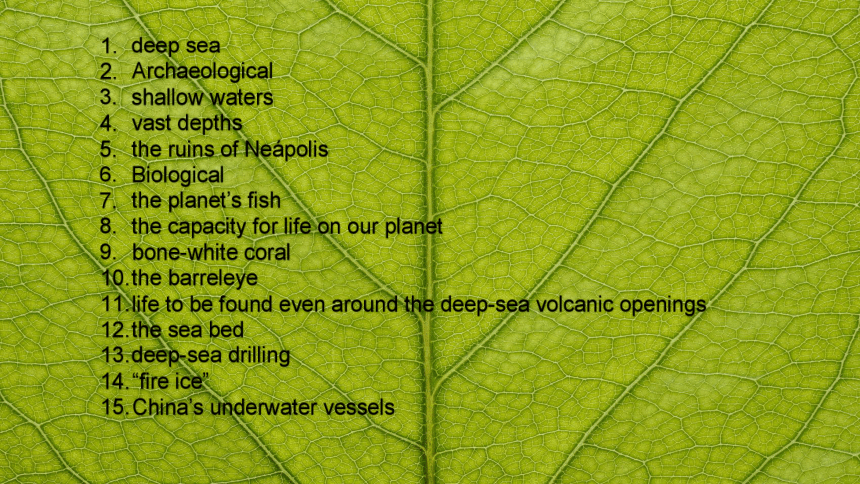
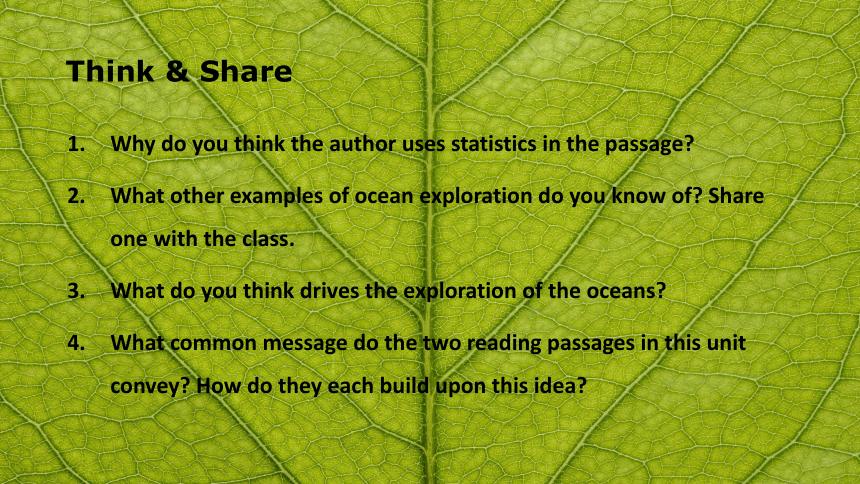
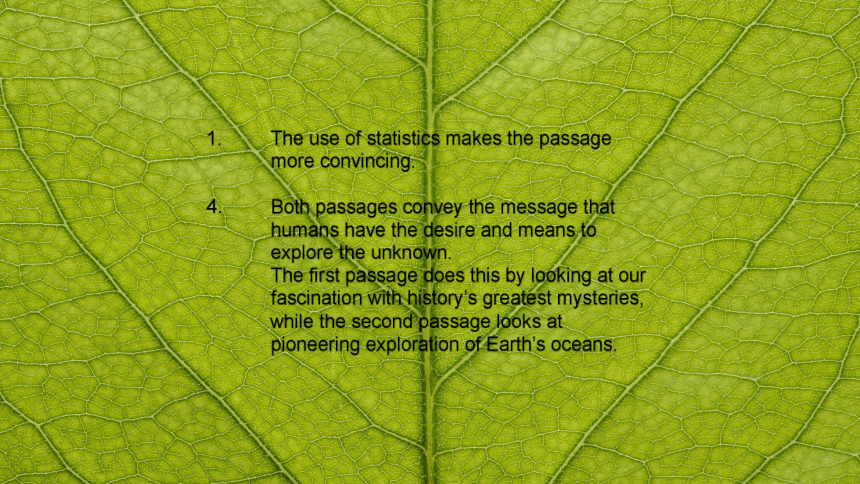
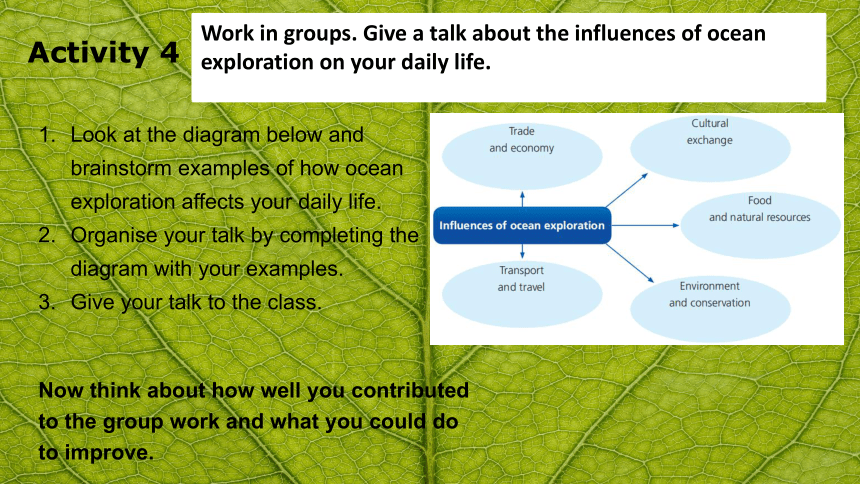
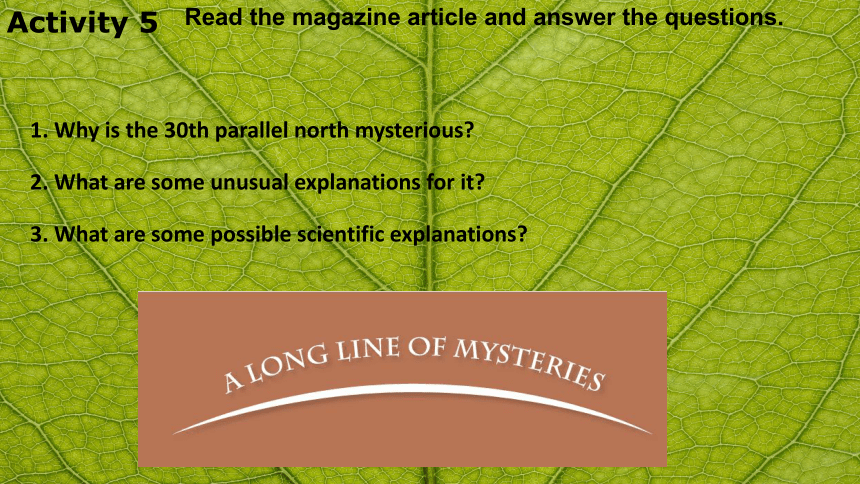
文档简介
(共20张PPT)
Unit 5 Into the unknown
Developing ideas
新标准《英语》高中选择性必修第四册
Activity 1
Look at the picture and answer the questions. Do further research if necessary.
What different zones are there in the ocean
Which parts of the ocean do you think have been explored
What do you know about the deepest part of the ocean
The different zones in the ocean are Sunlight Zone, Twilight Zone, Midnight Zone and Abyssal Zone.
Activity 2
Read the passage and find out what has been discovered in the ocean depths.
Shipwrecks such as that of the Esmeralda, ruins
of ancient cities like Neápolis, extraordinary
deep-sea creatures such as bone-white coral and
the barreleye, and the substance known as “fire
ice” have been discovered in the ocean depths.
Activity 3
Think about the structure of the passage and complete the diagram.
deep sea
Archaeological
shallow waters
vast depths
the ruins of Neápolis
Biological
the planet’s fish
the capacity for life on our planet
bone-white coral
the barreleye
life to be found even around the deep-sea volcanic openings
the sea bed
deep-sea drilling
“fire ice”
China’s underwater vessels
Think & Share
Why do you think the author uses statistics in the passage
What other examples of ocean exploration do you know of Share one with the class.
What do you think drives the exploration of the oceans
What common message do the two reading passages in this unit convey How do they each build upon this idea
1. The use of statistics makes the passage more convincing.
4. Both passages convey the message that humans have the desire and means to explore the unknown.
The first passage does this by looking at our
fascination with history’s greatest mysteries,
while the second passage looks at pioneering exploration of Earth’s oceans.
Activity 4
Work in groups. Give a talk about the influences of ocean exploration on your daily life.
Look at the diagram below and brainstorm examples of how ocean exploration affects your daily life.
Organise your talk by completing the diagram with your examples.
Give your talk to the class.
Now think about how well you contributed to the group work and what you could do to improve.
Activity 5
1. Why is the 30th parallel north mysterious
2. What are some unusual explanations for it
3. What are some possible scientific explanations
Read the magazine article and answer the questions.
The 30th parallel north is mysterious because it is where numerous sites of ancient civilisations and impressive natural features lie.
Some believe that the 30th parallel north is a line of great natural energy, with frequent earthquakes and volcanic eruptions, and others even claim that its amazing natural features were caused by supernatural powers.
Possible scientific explanations for the 30th parallel north include the generally warm and damp climate that made it a good place for civilisations to develop, and the fact that it is where major tectonic plates meet.
Activity 6
What is the unexplained phenomenon
Why is it mysterious
What non-scientific explanations are there
How do scientists explain it
Plan an article about an unexplained phenomenon. Do further research if necessary.
Now write your article.
Activity 7
Work in pairs. Make improvements to each other's articles and share them with the class.
The Bermuda Triangle
Far below the surface of the North Atlantic Ocean, in a roughly triangular area known as the Bermuda Triangle, lie more than 50 shipwrecks and 20 plane wrecks. What makes these wrecks so mysterious is that the cause
of their fate remains largely unknown – ships were abandoned without apparent reason, distress signals were never sent and aircraft were lost without trace. Some believe that supernatural forces are responsible, while others put the accidents and disappearances down to coincidence. Scientific theories, meanwhile, include pilot error when trying to navigate
the area, and huge “rogue waves” caused by terrible storms. Although many ships and planes cross the Bermuda Triangle without incident, the stories behind those doomed vessels’ fates continue to capture people’s imaginations.
Unit 5 Into the unknown
Presenting ideas
新标准《英语》高中选择性必修第四册
Activity 1
What is your understanding of the sentence
What does Proust mean by “The only true voyage of discovery”
Work in groups. Read the sentence and answer the questions.
Activity 2
Share your opinion of this sentence and make notes. Do further research if necessary.
Activity 3
Prepare a speech about what explanation means to you. Consider the following:
the structure of your speech
useful words, expressions and structures
helpful public speaking skills
Activity 4
Give your speech to the class.
Reflection
Write a reflection after completing this unit.Consider the following:
1 What is your understanding of the significance of exploration
2 What text types have you learnt about What are their features
3 What words,expressions and structures have you learnt
4 What improvement have you made in understanding different cultures
5 What improvement have you made in using learning strategies and exploring effective waysof learning
6 What improvement have you made in analysing and solving problems
THANK YOU
Unit 5 Into the unknown
Developing ideas
新标准《英语》高中选择性必修第四册
Activity 1
Look at the picture and answer the questions. Do further research if necessary.
What different zones are there in the ocean
Which parts of the ocean do you think have been explored
What do you know about the deepest part of the ocean
The different zones in the ocean are Sunlight Zone, Twilight Zone, Midnight Zone and Abyssal Zone.
Activity 2
Read the passage and find out what has been discovered in the ocean depths.
Shipwrecks such as that of the Esmeralda, ruins
of ancient cities like Neápolis, extraordinary
deep-sea creatures such as bone-white coral and
the barreleye, and the substance known as “fire
ice” have been discovered in the ocean depths.
Activity 3
Think about the structure of the passage and complete the diagram.
deep sea
Archaeological
shallow waters
vast depths
the ruins of Neápolis
Biological
the planet’s fish
the capacity for life on our planet
bone-white coral
the barreleye
life to be found even around the deep-sea volcanic openings
the sea bed
deep-sea drilling
“fire ice”
China’s underwater vessels
Think & Share
Why do you think the author uses statistics in the passage
What other examples of ocean exploration do you know of Share one with the class.
What do you think drives the exploration of the oceans
What common message do the two reading passages in this unit convey How do they each build upon this idea
1. The use of statistics makes the passage more convincing.
4. Both passages convey the message that humans have the desire and means to explore the unknown.
The first passage does this by looking at our
fascination with history’s greatest mysteries,
while the second passage looks at pioneering exploration of Earth’s oceans.
Activity 4
Work in groups. Give a talk about the influences of ocean exploration on your daily life.
Look at the diagram below and brainstorm examples of how ocean exploration affects your daily life.
Organise your talk by completing the diagram with your examples.
Give your talk to the class.
Now think about how well you contributed to the group work and what you could do to improve.
Activity 5
1. Why is the 30th parallel north mysterious
2. What are some unusual explanations for it
3. What are some possible scientific explanations
Read the magazine article and answer the questions.
The 30th parallel north is mysterious because it is where numerous sites of ancient civilisations and impressive natural features lie.
Some believe that the 30th parallel north is a line of great natural energy, with frequent earthquakes and volcanic eruptions, and others even claim that its amazing natural features were caused by supernatural powers.
Possible scientific explanations for the 30th parallel north include the generally warm and damp climate that made it a good place for civilisations to develop, and the fact that it is where major tectonic plates meet.
Activity 6
What is the unexplained phenomenon
Why is it mysterious
What non-scientific explanations are there
How do scientists explain it
Plan an article about an unexplained phenomenon. Do further research if necessary.
Now write your article.
Activity 7
Work in pairs. Make improvements to each other's articles and share them with the class.
The Bermuda Triangle
Far below the surface of the North Atlantic Ocean, in a roughly triangular area known as the Bermuda Triangle, lie more than 50 shipwrecks and 20 plane wrecks. What makes these wrecks so mysterious is that the cause
of their fate remains largely unknown – ships were abandoned without apparent reason, distress signals were never sent and aircraft were lost without trace. Some believe that supernatural forces are responsible, while others put the accidents and disappearances down to coincidence. Scientific theories, meanwhile, include pilot error when trying to navigate
the area, and huge “rogue waves” caused by terrible storms. Although many ships and planes cross the Bermuda Triangle without incident, the stories behind those doomed vessels’ fates continue to capture people’s imaginations.
Unit 5 Into the unknown
Presenting ideas
新标准《英语》高中选择性必修第四册
Activity 1
What is your understanding of the sentence
What does Proust mean by “The only true voyage of discovery”
Work in groups. Read the sentence and answer the questions.
Activity 2
Share your opinion of this sentence and make notes. Do further research if necessary.
Activity 3
Prepare a speech about what explanation means to you. Consider the following:
the structure of your speech
useful words, expressions and structures
helpful public speaking skills
Activity 4
Give your speech to the class.
Reflection
Write a reflection after completing this unit.Consider the following:
1 What is your understanding of the significance of exploration
2 What text types have you learnt about What are their features
3 What words,expressions and structures have you learnt
4 What improvement have you made in understanding different cultures
5 What improvement have you made in using learning strategies and exploring effective waysof learning
6 What improvement have you made in analysing and solving problems
THANK YOU
